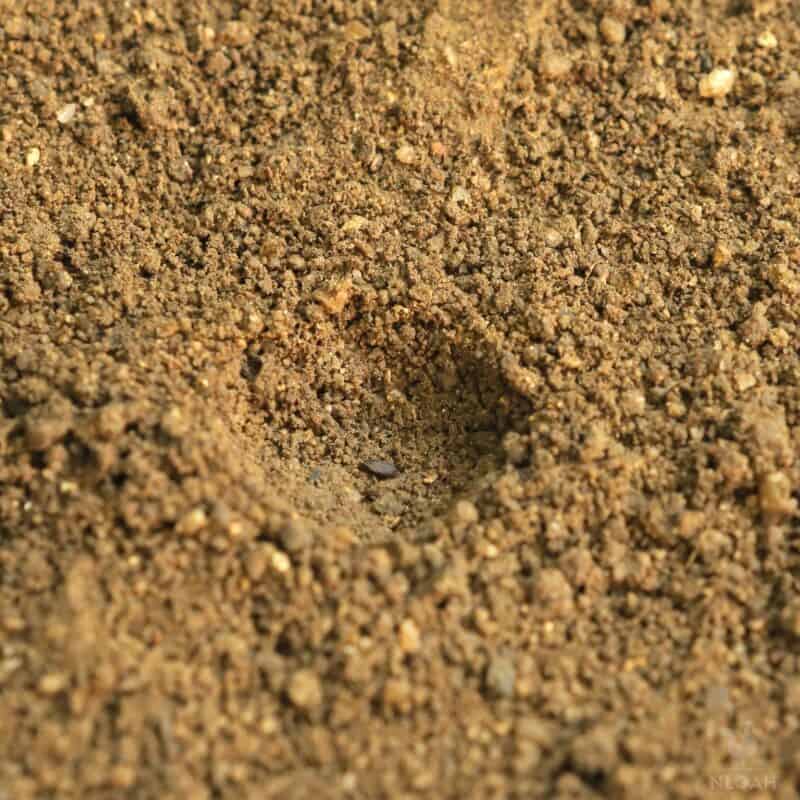Basil is one of the most beloved and popular herbs in use around the world, and one of the very easiest to grow in a home garden.

While basil it’s easy to grow, getting your plants started right is half the battle. So, how many basil seeds should you plant per hole?
Plant one basil seed per hole if using fresh, new seeds since it has a high germination rate. If using older seeds, however, you should plant two or three to ensure growth.
Basil has its own preferences and vulnerabilities like any plant, but assuming you can take care of the basic requirements, you’re all but guaranteed a bumper crop.
I’ll tell you everything else you need to know about growing basil from seed below…
How Deep Should You Plant Basil Seeds?
Basil seeds don’t need to be planted very deep at all. Approximately a ¼ inch (6-7 millimeters) is all it takes.
How Wide Should the Hole for Basil Seeds Be?
Basil also does need a wide hole in order to be grown from seed. A hole only 1 inch (5 centimeters) wide is more than adequate.
What Special Preparations Should You Make When Planting Basil Seeds?
Basil is one of the definitive herbs for warm weather conditions, so much so that you shouldn’t even try to get it going outside until temps are reliably holding steady around 70 °F / 21 °C during the day, and never getting close to frost temps at night.
Frost can easily kill basil straight away if you’re not careful…
If you’re planning on getting them started indoors, you can start them very early in the season, about 45 days prior to the last projected frost.
Don’t overcrowd your plants for best results: crowding results in quickly spreading diseases and fungus issues, a common problem for basil. 1 foot to 1 ½ foot spacing is ideal.
Basil also needs lots and lots of sunshine, preferable 8 hours of full, direct sun. Less sun means basil of lesser quality and also a higher likelihood of various diseases.
Soil conditions are the next most critical element: Ensure your basil gets regular, soaking water but that the soil drains well.
You want it to stay good and damp, but not truly wet, and mulch can help significantly with this requirement once you have the drainage figured out.
Never let the roots sit in accumulated water; ensure all containers or planting sites are well drained!
Consider enriching the soil with compost prior to planting, too, and be ready with the fertilizer as the plants grow; most people harvest basil from their plants continuously, and that means they will be using lots of resources to grow more leaves, so they will need the nutrients!
How Long Until You Can Harvest Basil When Planting from Seed?
You can start harvesting basil leaves in as little as 21 days, but some varieties may take as long as 3 months to fully mature depending on conditions.
As soon as the plant is around 7 inches (18 centimeters) tall, you can (and should!) start harvesting the top-most leaves; this will help prevent the plant from flowering.
Even if you don’t need the leaves for recipes, pluck them regularly!
Can You Plant Basil Seed Indoors?
Yes, basil usually does wonderfully indoors and takes well to container planting.
Special Care if Planting Basil Seeds Indoors
Follow all of the guidelines laid out above, and stick to larger, deeper containers if you want to grow multiple plants or a taller narrow container for just one.
This will help with drainage and make it easier to keep the roots out of any accumulating water.
Make sure each plant has plenty of room and give them good air circulation to help prevent diseases like fungus and mildew.
If you are planning to transfer your plants outdoors, you must be totally sure that all risk of frost has passed and that the temperatures won’t dip down toward freezing.
Even a kiss of frost can blacken or kill your basil, and basil is always the very first summertime plant to die when fall closes in!
Whether you are planning on putting your plants in the ground or leaving them in containers when outside, be sure to harden them off.
Set your containers out in a shady area and let them get used to the outdoors for a couple of hours each day prior to transplanting before bringing them inside again.
Increase the time they’re outdoors by about 30 minutes each day, and repeat the process for 1 to 2 weeks. At the end, they will be ready for their new home.
Hardening off is critical to help ensure that they don’t suffer from transplant shock when moved outdoors, as it can kill your plants!
Finally, don’t forget to double-check the drainage once they’re outside, and use mulch if needed to hold in a little moisture.
Tom has lived and worked on farms and homesteads from the Carolinas to Kentucky and beyond. He is passionate about helping people prepare for tough times by embracing lifestyles of self-sufficiency.
